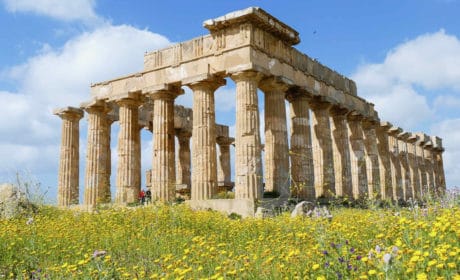Have you thought about exploring Greek and Roman history on a Syracuse shore excursion? Alan and I thoroughly enjoyed our excursion in Syracuse, one of Sicily’s most historic cities.
On a Mediterranean cruise, active boomer travelers will find plenty of historical sites to explore. And by history, I mean some of the most ancient places you’ll ever visit.
I’ve walked the ruins of Ephesus, investigated the ancient city of Nora and stood among wildflowers in front of Greek temples at Selinunte—all while participating in Mediterranean cruise excursions.
But when Alan and I cruised on a Silver Wind spring cruise in the Mediterranean, we hit the historical jackpot on a Syracuse shore excursion.

You could argue the point that there’s almost too much history to see in Syracuse, Sicily—or Siracusa, as the Italians say. Located on Sicily’s Ionian Coast, Syracuse is known as one of western civilization’s greatest ancient capitals.
The entire city is a UNESCO World Heritage site, having the largest concentration of Greek ruins outside of Greece.
I’ll be honest, when exploring archaeological sites and ancient buildings, a little goes a long way. Alan and I get much more out of a half-day informative shore excursion than dragging through ruins an entire day. I guess you could say that we like our history in short bites so that we can chew on it for a while.
Table of Contents
What to expect on a Siracusa shore excursion

We tendered to Syracuse (Siricusa) from the Silver Wind in perfect May weather. I can’t imagine how hot it would be in the blazing summer sun.
But, of course, you already know that I recommend spring or fall Mediterranean cruises over the busy, and extremely hot, summer season. However if a summer visit is your only choice, follow my advice for surviving a summer cruise in the Mediterranean.
Our Syracuse cruise excursion was mostly a walking tour, although we were bussed between sites. And we lucked out that fellow passengers listened, didn’t talk over the guide, or keep the group waiting. They also asked just enough questions to make the tour interesting without dragging the group down with over-involved discussion.
Boomer Travel Tip
MedjetAssist Members who are hospitalized 150 miles from home receive medical transport to a home-country hospital of choice. Memberships from $99.
We begin at the Neapolis Archaeological Park

Of all the things to do in Syracuse, Neapolis Archaeological Park is at the top of the list. Founded by Greek colonists from Corinth in 734 BC, Syracuse became the wealthiest city-state in the western world. The city’s power and influence surpassed that of Athens.
Siracusa remained powerful for two centuries, until the Romans conquered the city-state. The sites we visited at the archeological park provide a glimpse into life during the ancient times of the Greeks and Romans.
Altar of Heiron II
After entering by the ticket booth, the group stops at the Altar of Heiron II to listen to our guide’s interpretation of its historical significance. Although Spaniards destroyed much of the altar in the 16th century, the remains are impressive.
According to our guide, it’s the largest altar from antiquity that we know about. Imagine 450 oxen being sacrificed on top of the altar at the same time. Yes, it’s that big.
The Greek Theatre

And now it’s time to explore the jewel of Neapolis Archaeological Park, the Greek Theatre (or Teatro Greco). It does not disappoint, except for the scaffolding over some of the stone seats.
A construction crew works to set up the seating section—also known as cavea—for the annual Greek Theatre festival held from mid-May until the end of June. With 59 rows and seats for 15,000 spectators, this is the largest theater ever built by the ancient Greeks. Of course not all of it remains today.
Ear of Dionysius

After time to explore on our own, the group continues behind the cavea to Paradise Quarry, where limestone rocks were extracted for building the theater. Today, it truly is a paradise that’s shaded by lemon and orange trees, but in ancient times, the quarry probably wasn’t such a pleasant working environment for the slaves who mined the limestone.
Excavating all that rock created a cave known as the Ear of Dionysius, famous for its acoustical properties. However this article from Atlas Obscura suggests it is a natural cave and debunks some of the myths surrounding the cave.
Boomer Travel Tip
In today’s travel climate, trip insurance is a must. Compare policies and rates at InsureMyTrip.
Roman Amphitheatre

This part of the tour ends with a visit to the Roman Amphitheatre. Standing at an overlook, I imagine what it must have been like to attend gladiator fights at one of the largest amphitheatres ever constructed.
Finding the historic center of Syracuse at the island of Ortigia

And now we’re back on the bus for the ride through the city to the drop-off point for Ortigia where the Syracuse walking tour continues. The historic heart of Syracuse—and also part of the UNESCO World Heritage site designation—this island is made for strolling.
The journey begins at the Temple of Apollo, where remnants of antiquity, including two Doric columns, hold secrets from 6th century BC and more. Imagine being part of the 1930’s excavation team to discover the oldest Doric temple in Sicily.
Through time, the huge Greek temple evolved to a Byzantine church and then a Muslim mosque before becoming a church again. Yes, there are definitely some historical secrets in these remains.

And then the true stroll begins as the group meanders down narrow, winding streets to one of the most beautiful piazzas in Sicily—Piazza Duomo. The Cathedral of Syracuse sits on one corner. But the Temple of Athena (built in 5 BC) stood here first.
Visiting inside the cathedral reveals a wall of ancient, Greek temple columns, thanks to the historic builders who wrapped the building around the temple. It probably wasn’t their intention to preserve ancient Greek history but I’m so glad that they did.

The Church of Saint Lucia stands at the end of the large Piazza Duomo. It houses the painting, Burial of Saint Lucy by Caravaggio.
Boomer Travel Tip
Will you be cruising in the Mediterranean? Before booking an excursion, check out our Mediterranean shore excursion reviews.

Continuing toward the harbor, we arrive at the Fountain of Aretusa. Like in ancient times, papyrus still grows around the fresh water spring that connects to the sea. It’s a pleasant spot to reflect on the thousands of years of history we’ve just seen before walking to the pier to catch the tender back to the Silver Wind.
Boomer Travel Tip
Need help dressing for a cruise? Be sure to ready my tips in luxury cruise wear for women.
Save to Pinterest




